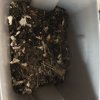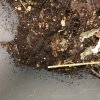myke
Well-Known Member
I’ve had it for 3 months or so now. I’ve been feeding a mix of dry nutes. Kelp,alfalfa etc. And some Veggies scraps. I’ve been adding cardboard ,shredded paper etc. Old root balls chopped up stems. I was going to grab a few hand fulls from the bottom. See pic. To add to my plants. When I got the farm it had a bunch of dry leaves so it was a little more fluffy.
So question. Should I turn the whole lot. The worms hang down at the bottom where there’s a lot more castings. I’d like to harvest some of them. So would it be ok to mix the whole tub after I harvest some out?? Perhaps a little more shredded paper or?
thanks.
So question. Should I turn the whole lot. The worms hang down at the bottom where there’s a lot more castings. I’d like to harvest some of them. So would it be ok to mix the whole tub after I harvest some out?? Perhaps a little more shredded paper or?
thanks.












